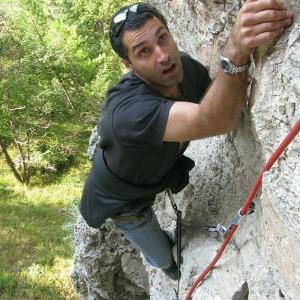
Zeo hollow building bricks & pouches by SAADITHYA
 Ralf Lippold Jun 29, 2017 04:40 | Thank you for your contribution to the contest with a concept that is under research currently at various places. In order to advance your project idea here some questions that come to mind:
|
 Aadhithya Sujith Jul 4, 2017 12:24 | Proposal contributor Hi Ralf, Thanks for your insightful questions, I have updated the proposals with more details. It is still a work in progress, I am deeply researching the proposal and will post more detailed update after consolidating my findings. However I will try to answer your queries. Where have been similar approaches with heat storage solutions in building material been undertaken? Zeolite heat storage solutions have been used in many industries including refrigerators, it is not widely researched in building sector especially in a way I am proposing inside hollow bricks filled with Zeolites. So this an innovative approach and might come with new challenges as well. Here is a link to proof of concept. http://www.gimvic.org/dogodki/I-sweeep_2013/files/abstract-zeolites.pdf/ A research paper on "NATURAL ZEOLITES IN THERMAL ADSORPTION STORAGE AND BUILDING MATERIALS" http://comtes-storage.eu/wordpress/wp-content/uploads/2015/06/SASEC2015_janchen.pdf
2.In case there are already working prototypes of 1., what are possible reasons/constraints (technically) to scale? Prototypes can easily be built, I have earlier built the same for a technical seminar live demo for my final semester mechanical Engineering. Hollow bricks are easily available, getting the right zeolites is the only challenge tubular arrangement I used was small PVC pipes. There are no major challenges for scaling it. Getting building safety clearance will take some time for commercial implementation but it can be done with proper research and justification of measurable results taking into account safety. 3.What steps have you taken to get feedback from brick building companies and construction industry? ClimateColab is the first online community where I have openly discussed this idea of mine so I am hoping to get some insightful and constructive feedback. As far as my closed group of people which included a few senior professors who were evaluating my seminar, I got a Thumbs up and certainly a technology to explore given the benefits. Since you mentioned brick industry, I recently came across this video where they make hollow bricks at home. https://www.youtube.com/watch?v=b3vK5HQlj7o Thanks & regards Aadhithya
|
 Betsy Hands Jul 12, 2017 12:28 | Thanks for this proposal. It sounds very interesting and promising. I am interested in a few things: 1. Along with energy efficiency, I would like to make sure that the zeolite would meet healthy indoor air requirements. What can you tell us about its off gassing properties and how would you prevent mold development? 2. Given that you are using water to activate the zeolite - In what climate is this technology most applicable? Does this work in northern climates and if so, are you proposing a passive design house? Or would some houses need supplemental heating? 3. To my knowledge, most northern single family housing is built with lumber and insulation in the U.S - just wondering about adoption in U.S. versus other geographies. How did you choose your locations? Thanks again. |
 Aadhithya Sujith Jul 22, 2017 08:29 | Proposal contributor @Betsy Hands Thanks for your feedback. Please find my comments below. 1. Along with energy efficiency, I would like to make sure that the zeolite would meet healthy indoor air requirements. What can you tell us about its off gassing properties and how would you prevent mold development? Zeolites do not produce any harmful gases, instead it is a versatile air pollutant adsorber so I believe it is safe & will meet healthy indoor air. https://www3.epa.gov/ttn/catc/dir1/fzeolite.pdf "Natural zeolite acts as a molecular sieve that prevents and eliminates mold by absorbing moisture and trapping odors. Because of its porosity and cation exchange capacity, noxious odors are trapped inside its crystalline structure and removed from the surrounding environment." https://www.kmizeolite.com/zeolite-applications/absorbent-and-adsorbent/mold-absorption/ 2. Given that you are using water to activate the zeolite - In what climate is this technology most applicable? Does this work in northern climates and if so, are you proposing a passive design house? Or would some houses need supplemental heating? This is most suitable in areas with good sunlight with short days and cold weather at nights. Yes this would work in northern climates too, if we are talking about below freezing conditions then a small amount of antifreeze(Ethylene glycol) should do the job, however the zeolite needs to be recharged with solar or heat energy from other sources. The passive and active designs depends on the location this is incorporated, in regions with regular solar energy this could be an active design and in places where solar energy is limited it could be a passive design. 3. To my knowledge, most northern single family housing is built with lumber and insulation in the U.S - just wondering about adoption in U.S. versus other geographies. How did you choose your locations? Yes you are correct, similar to hollow bricks this can also be incorporated in Lumber & insulation also with a change in design but the working principle will be same. In case of wood and insulation, Zeolites are filled in Aluminium pouches connected with small water tubes, this will be embedded in lumber. Thanks & regards Aadhithya |
 Christo Krastev Jul 23, 2017 05:00 | Hello, regards, Krastev |
 Aadhithya Sujith Aug 12, 2017 08:07 | Proposal contributor Hi Krastev, Thanks for your feedback, I really appreciate it. Let me try to answer some of the questions you have raised. How will you protect the brittle zeolite from freezing? My proposal proposes to use Zeolite into a thermal storage system, so ideally these thermal storage system needs to be charged up with heat from other sources, just like a power bank in the mobile. This addition of energy to zeolite stops the zeolite from freezing, if the energy is just enough to get the water to liquid state then the zeolite can start binding with water molecules and the exothermic reaction can pick up. f we are talking about below freezing conditions then a small amount of antifreeze(Ethylene glycol) should do the job, however the zeolite needs to be recharged with solar or heat energy from other sources. How will you prevent water-soaked zeolite from plant growth? Because they grow up very fast and feel very good. Unlike water absorbed in bricks or wood which can be used by plants for growth. Zeolites do not easily release water molecules from its surface easily a considerable amount of heat energy has to be provided to release these water molecules. So plants will find it difficult to grow on zeolites also there will be very less scope for gaseous exchange as we are planning to use it in confined environment. Do you have any idea how to produce zeolites for building materials? There are two types of zeolites Natural & Artificial.Conventional open-pit mining techniques are used to mine natural zeolites.The ore may be blasted or stripped for processing by using tractors equipped with ripper blades and front-end loaders. In processing, the ore is crushed, dried, and milled. There are over 200 synthetic zeolites that have been synthesized by a process of slow crystallization of a silica-alumina gel in the presence of alkalis and organic templates. Thanks & regards Aadhithya |
 Pia Jensen Aug 15, 2017 10:43 | Have you considered using, instead of clay, blocks made from plastic? 1) These LEGO-like recycled plastic bricks create sturdy homes for just $5200 inhabitat.com/lego-like-building-blocks-of-recycled-plastic-allow-colombians-to-build-their-own-homes/ 2) Ecobricks: Plastic, Solved. www.ecobricks.org These plastic bricks resolve waste issues with plastic materials, are lightweight, easy to put together, and could be adapted to act as heat sinks and to facilitate cooling through the design of the bricks using passive heating and cooling engineering. 1) Earthtubing for sustainable, passive geothermal heating & cooling https://www.thenaturalhome.com/earthtube.htm 2) DIY Simple & Dirt Cheap Alternative & Sustainable Heating & Cooling System https://www.youtube.com/watch?v=dxVGm9elZjk |
 Aadhithya Sujith Aug 27, 2017 12:44 | Proposal contributor @Pia Jensen Thanks for the links to plastic bricks, yes I could see this working with something like plastic bricks too. I like the way it fits easily like LEGO bricks and it is a great way to recycle plastic & rubber. However I think these could work only as temporary shelter or the inner structures within the house like wall partitions because there are chances that people could break into houses by just melting the plastic from the outside. Thanks & regards Aadhithya |
 Teerth Brahmbhatt Aug 27, 2017 05:25 | Dear Aadhithya,
Best Regards, Teerth Brahmbhatt
|
 Aadhithya Sujith Sep 10, 2017 10:16 | Proposal contributor Hi Teerth Brahmbhatt , Thanks for your feedback.
Yes, I think it still holds good.
Good point here, Yes we will create a prototype & measure the results for a period of few months monitoring temperature & other parameters with IOT sensors using this data we will be able to measure the energy savings it produced and compare it with fossil fuels/electricity needed to achieve same results. The results from the pilot will be used for pitch & we will be able to define the payback period. Do you know of any partners you could use to study this and receive a lab based measure? U.S Energy department is great candidate for partner, MIT should also be able to help with lab tests & there is some researchers in Germany who are working very hard to use zeolites as a thermal storage device, may be they could also help. Thanks & regards Aadhithya |